The Use and Impact of Sweatshops: A Case Study of Wal-Mart
VerifiedAdded on 2023/06/11
|10
|2769
|490
AI Summary
This paper analyzes the reasons why companies use sweatshops, with a focus on Wal-Mart. It also discusses the impact of sweatshops on businesses and society.
Contribute Materials
Your contribution can guide someone’s learning journey. Share your
documents today.
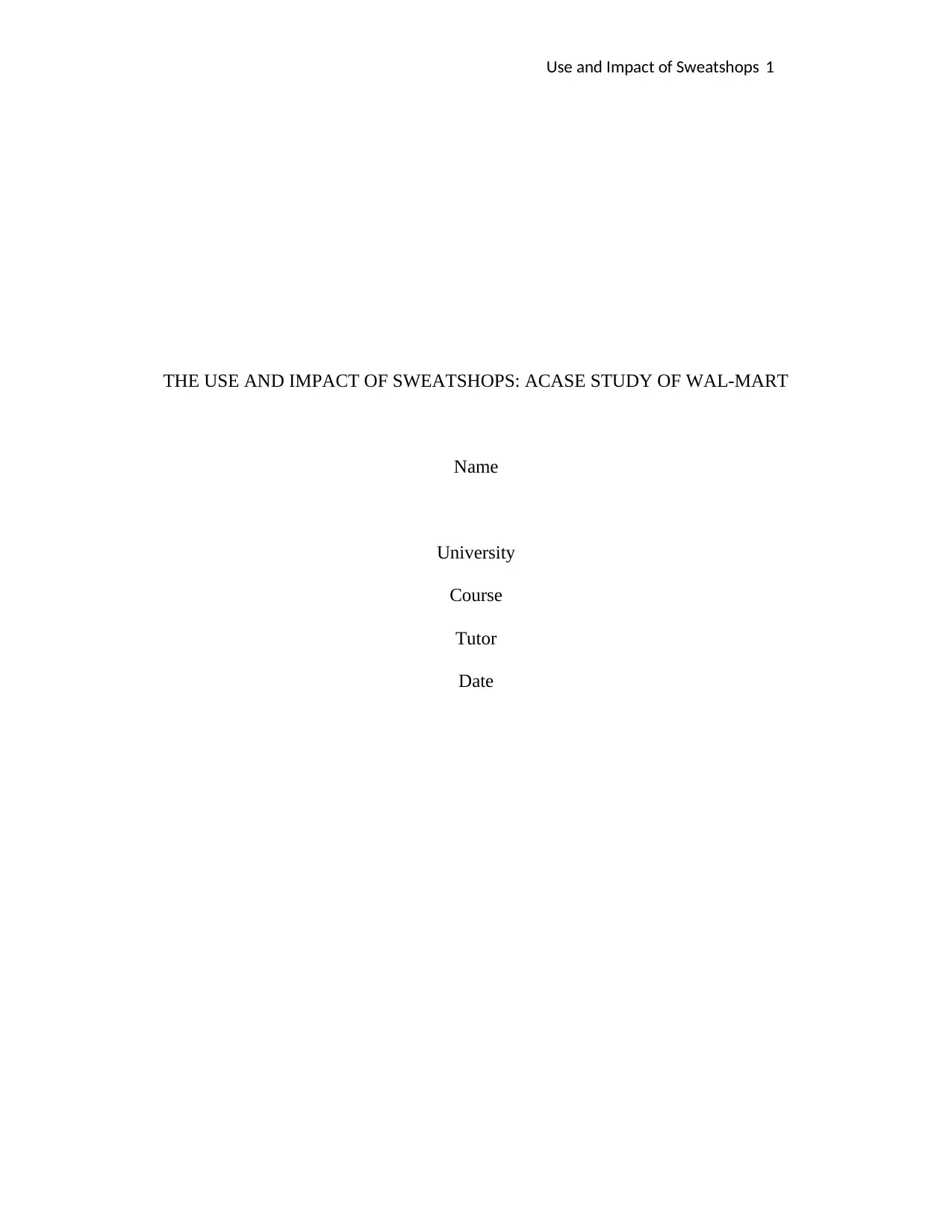
Use and Impact of Sweatshops 1
THE USE AND IMPACT OF SWEATSHOPS: ACASE STUDY OF WAL-MART
Name
University
Course
Tutor
Date
THE USE AND IMPACT OF SWEATSHOPS: ACASE STUDY OF WAL-MART
Name
University
Course
Tutor
Date
Secure Best Marks with AI Grader
Need help grading? Try our AI Grader for instant feedback on your assignments.
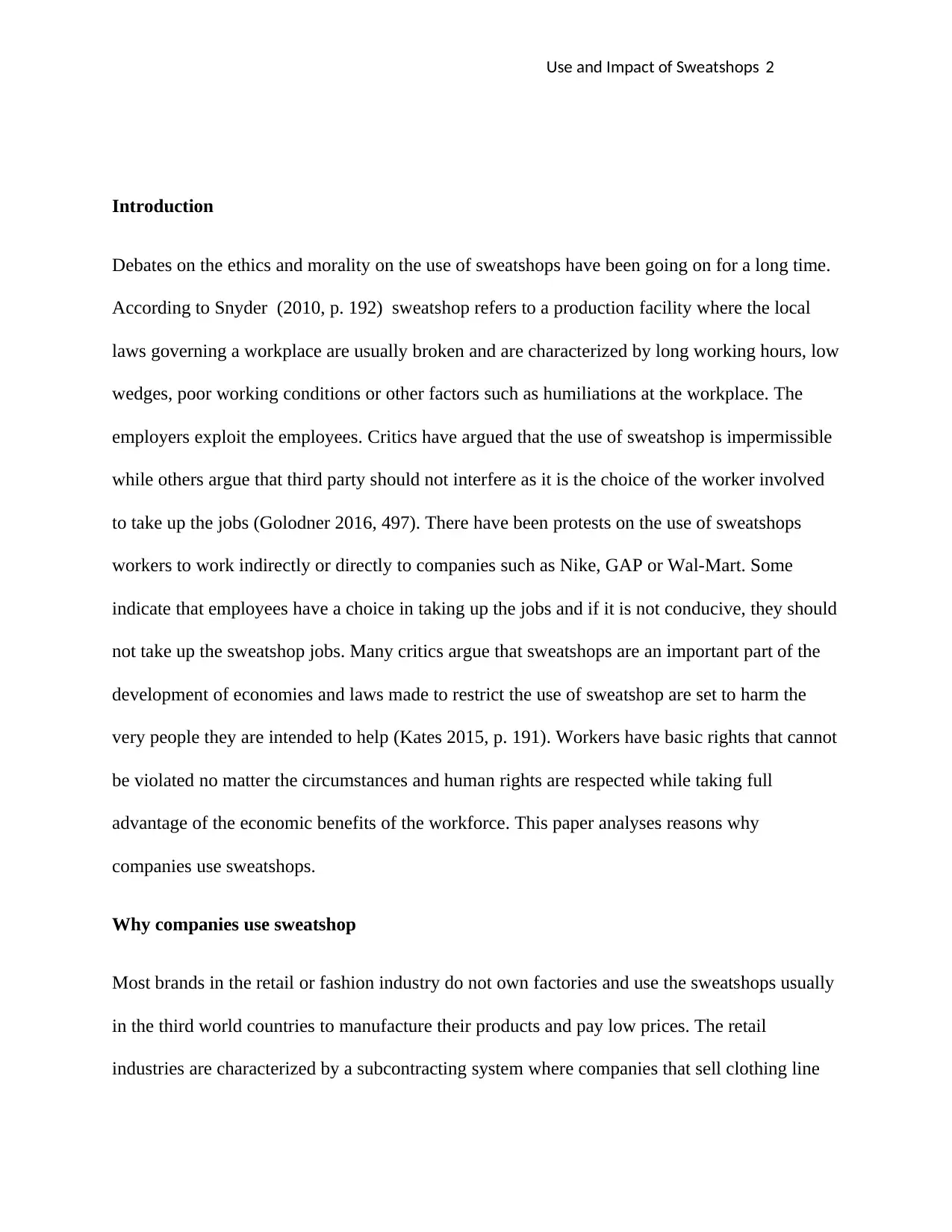
Use and Impact of Sweatshops 2
Introduction
Debates on the ethics and morality on the use of sweatshops have been going on for a long time.
According to Snyder (2010, p. 192) sweatshop refers to a production facility where the local
laws governing a workplace are usually broken and are characterized by long working hours, low
wedges, poor working conditions or other factors such as humiliations at the workplace. The
employers exploit the employees. Critics have argued that the use of sweatshop is impermissible
while others argue that third party should not interfere as it is the choice of the worker involved
to take up the jobs (Golodner 2016, 497). There have been protests on the use of sweatshops
workers to work indirectly or directly to companies such as Nike, GAP or Wal-Mart. Some
indicate that employees have a choice in taking up the jobs and if it is not conducive, they should
not take up the sweatshop jobs. Many critics argue that sweatshops are an important part of the
development of economies and laws made to restrict the use of sweatshop are set to harm the
very people they are intended to help (Kates 2015, p. 191). Workers have basic rights that cannot
be violated no matter the circumstances and human rights are respected while taking full
advantage of the economic benefits of the workforce. This paper analyses reasons why
companies use sweatshops.
Why companies use sweatshop
Most brands in the retail or fashion industry do not own factories and use the sweatshops usually
in the third world countries to manufacture their products and pay low prices. The retail
industries are characterized by a subcontracting system where companies that sell clothing line
Introduction
Debates on the ethics and morality on the use of sweatshops have been going on for a long time.
According to Snyder (2010, p. 192) sweatshop refers to a production facility where the local
laws governing a workplace are usually broken and are characterized by long working hours, low
wedges, poor working conditions or other factors such as humiliations at the workplace. The
employers exploit the employees. Critics have argued that the use of sweatshop is impermissible
while others argue that third party should not interfere as it is the choice of the worker involved
to take up the jobs (Golodner 2016, 497). There have been protests on the use of sweatshops
workers to work indirectly or directly to companies such as Nike, GAP or Wal-Mart. Some
indicate that employees have a choice in taking up the jobs and if it is not conducive, they should
not take up the sweatshop jobs. Many critics argue that sweatshops are an important part of the
development of economies and laws made to restrict the use of sweatshop are set to harm the
very people they are intended to help (Kates 2015, p. 191). Workers have basic rights that cannot
be violated no matter the circumstances and human rights are respected while taking full
advantage of the economic benefits of the workforce. This paper analyses reasons why
companies use sweatshops.
Why companies use sweatshop
Most brands in the retail or fashion industry do not own factories and use the sweatshops usually
in the third world countries to manufacture their products and pay low prices. The retail
industries are characterized by a subcontracting system where companies that sell clothing line
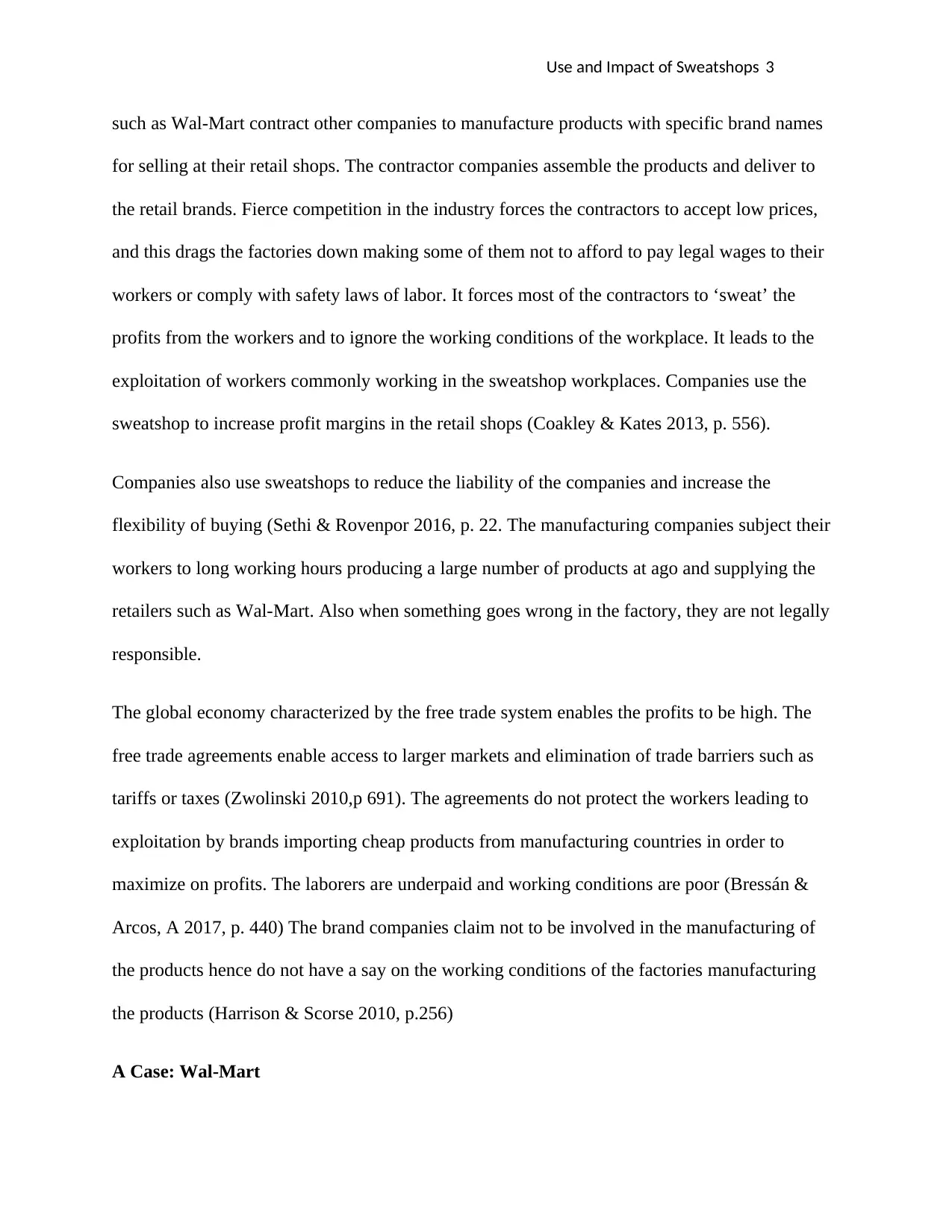
Use and Impact of Sweatshops 3
such as Wal-Mart contract other companies to manufacture products with specific brand names
for selling at their retail shops. The contractor companies assemble the products and deliver to
the retail brands. Fierce competition in the industry forces the contractors to accept low prices,
and this drags the factories down making some of them not to afford to pay legal wages to their
workers or comply with safety laws of labor. It forces most of the contractors to ‘sweat’ the
profits from the workers and to ignore the working conditions of the workplace. It leads to the
exploitation of workers commonly working in the sweatshop workplaces. Companies use the
sweatshop to increase profit margins in the retail shops (Coakley & Kates 2013, p. 556).
Companies also use sweatshops to reduce the liability of the companies and increase the
flexibility of buying (Sethi & Rovenpor 2016, p. 22. The manufacturing companies subject their
workers to long working hours producing a large number of products at ago and supplying the
retailers such as Wal-Mart. Also when something goes wrong in the factory, they are not legally
responsible.
The global economy characterized by the free trade system enables the profits to be high. The
free trade agreements enable access to larger markets and elimination of trade barriers such as
tariffs or taxes (Zwolinski 2010,p 691). The agreements do not protect the workers leading to
exploitation by brands importing cheap products from manufacturing countries in order to
maximize on profits. The laborers are underpaid and working conditions are poor (Bressán &
Arcos, A 2017, p. 440) The brand companies claim not to be involved in the manufacturing of
the products hence do not have a say on the working conditions of the factories manufacturing
the products (Harrison & Scorse 2010, p.256)
A Case: Wal-Mart
such as Wal-Mart contract other companies to manufacture products with specific brand names
for selling at their retail shops. The contractor companies assemble the products and deliver to
the retail brands. Fierce competition in the industry forces the contractors to accept low prices,
and this drags the factories down making some of them not to afford to pay legal wages to their
workers or comply with safety laws of labor. It forces most of the contractors to ‘sweat’ the
profits from the workers and to ignore the working conditions of the workplace. It leads to the
exploitation of workers commonly working in the sweatshop workplaces. Companies use the
sweatshop to increase profit margins in the retail shops (Coakley & Kates 2013, p. 556).
Companies also use sweatshops to reduce the liability of the companies and increase the
flexibility of buying (Sethi & Rovenpor 2016, p. 22. The manufacturing companies subject their
workers to long working hours producing a large number of products at ago and supplying the
retailers such as Wal-Mart. Also when something goes wrong in the factory, they are not legally
responsible.
The global economy characterized by the free trade system enables the profits to be high. The
free trade agreements enable access to larger markets and elimination of trade barriers such as
tariffs or taxes (Zwolinski 2010,p 691). The agreements do not protect the workers leading to
exploitation by brands importing cheap products from manufacturing countries in order to
maximize on profits. The laborers are underpaid and working conditions are poor (Bressán &
Arcos, A 2017, p. 440) The brand companies claim not to be involved in the manufacturing of
the products hence do not have a say on the working conditions of the factories manufacturing
the products (Harrison & Scorse 2010, p.256)
A Case: Wal-Mart
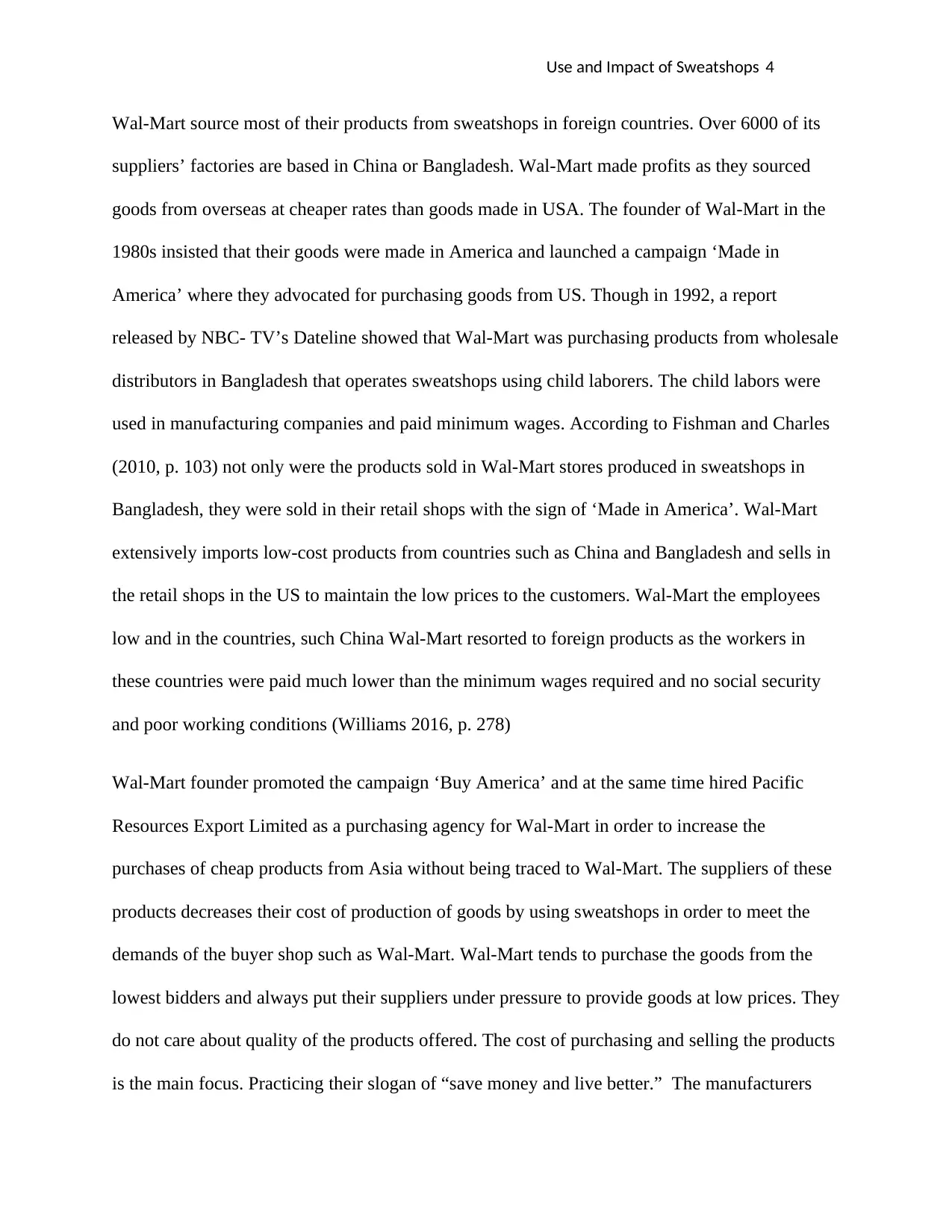
Use and Impact of Sweatshops 4
Wal-Mart source most of their products from sweatshops in foreign countries. Over 6000 of its
suppliers’ factories are based in China or Bangladesh. Wal-Mart made profits as they sourced
goods from overseas at cheaper rates than goods made in USA. The founder of Wal-Mart in the
1980s insisted that their goods were made in America and launched a campaign ‘Made in
America’ where they advocated for purchasing goods from US. Though in 1992, a report
released by NBC- TV’s Dateline showed that Wal-Mart was purchasing products from wholesale
distributors in Bangladesh that operates sweatshops using child laborers. The child labors were
used in manufacturing companies and paid minimum wages. According to Fishman and Charles
(2010, p. 103) not only were the products sold in Wal-Mart stores produced in sweatshops in
Bangladesh, they were sold in their retail shops with the sign of ‘Made in America’. Wal-Mart
extensively imports low-cost products from countries such as China and Bangladesh and sells in
the retail shops in the US to maintain the low prices to the customers. Wal-Mart the employees
low and in the countries, such China Wal-Mart resorted to foreign products as the workers in
these countries were paid much lower than the minimum wages required and no social security
and poor working conditions (Williams 2016, p. 278)
Wal-Mart founder promoted the campaign ‘Buy America’ and at the same time hired Pacific
Resources Export Limited as a purchasing agency for Wal-Mart in order to increase the
purchases of cheap products from Asia without being traced to Wal-Mart. The suppliers of these
products decreases their cost of production of goods by using sweatshops in order to meet the
demands of the buyer shop such as Wal-Mart. Wal-Mart tends to purchase the goods from the
lowest bidders and always put their suppliers under pressure to provide goods at low prices. They
do not care about quality of the products offered. The cost of purchasing and selling the products
is the main focus. Practicing their slogan of “save money and live better.” The manufacturers
Wal-Mart source most of their products from sweatshops in foreign countries. Over 6000 of its
suppliers’ factories are based in China or Bangladesh. Wal-Mart made profits as they sourced
goods from overseas at cheaper rates than goods made in USA. The founder of Wal-Mart in the
1980s insisted that their goods were made in America and launched a campaign ‘Made in
America’ where they advocated for purchasing goods from US. Though in 1992, a report
released by NBC- TV’s Dateline showed that Wal-Mart was purchasing products from wholesale
distributors in Bangladesh that operates sweatshops using child laborers. The child labors were
used in manufacturing companies and paid minimum wages. According to Fishman and Charles
(2010, p. 103) not only were the products sold in Wal-Mart stores produced in sweatshops in
Bangladesh, they were sold in their retail shops with the sign of ‘Made in America’. Wal-Mart
extensively imports low-cost products from countries such as China and Bangladesh and sells in
the retail shops in the US to maintain the low prices to the customers. Wal-Mart the employees
low and in the countries, such China Wal-Mart resorted to foreign products as the workers in
these countries were paid much lower than the minimum wages required and no social security
and poor working conditions (Williams 2016, p. 278)
Wal-Mart founder promoted the campaign ‘Buy America’ and at the same time hired Pacific
Resources Export Limited as a purchasing agency for Wal-Mart in order to increase the
purchases of cheap products from Asia without being traced to Wal-Mart. The suppliers of these
products decreases their cost of production of goods by using sweatshops in order to meet the
demands of the buyer shop such as Wal-Mart. Wal-Mart tends to purchase the goods from the
lowest bidders and always put their suppliers under pressure to provide goods at low prices. They
do not care about quality of the products offered. The cost of purchasing and selling the products
is the main focus. Practicing their slogan of “save money and live better.” The manufacturers
Secure Best Marks with AI Grader
Need help grading? Try our AI Grader for instant feedback on your assignments.

Use and Impact of Sweatshops 5
tend to cut cost on the safety of workers to meet the demand of low prices from the buyer
(Sollars & Englander 2018, p. 24). There is also competition between these countries and in case
they do not lower the price of their products, Wal-Mart moves to other countries with lower rates
for their supplies (Cahill, Gutiérrez & Quijada 2016, p. 132).
According to a research conducted by SACOM, some of the factories identified to be supplying
toys to Wal-Mart have imposed a six days’ workweek and a minimum of 11 working hours a day
for its workers, making it past 60 working hours recommended by Wal-Mart to its suppliers.
These hours are pure exploitation on the health and human rights of the workers. The limited
business time to deliver most of the products and lack enough money to pay workers hence
workers are exploited and forced to work more hours to meet the demand for the products (Man-
Cheong 2013, p. 252).
Wal-Mart has denied involvement in the use of products produced in sweatshop condition in
their store. Speaking against a report released by The National Labour Committee in the USA
claiming ornaments sold by Wal-Mart Stores Inc., Bentonville were made in sweatshop factories.
Richard J. Coyle, director of international corporate affairs for Wal-Mart, stated that "As soon as
Wal-Mart learned about the Christmas tree ornament report, we contacted the National Labor
Committee, and they have not returned our call. Now that we have a copy of their report, we
have launched an immediate investigation. Wal-Mart aggressively deals with any allegations of
improper conditions at our suppliers' factories. Wal-Mart maintains a very strict Supplier's Code
of Conduct, and employs over 200 people to monitor our suppliers and their designated factories'
adherence.”
The impact for sweatshop for business and the society
tend to cut cost on the safety of workers to meet the demand of low prices from the buyer
(Sollars & Englander 2018, p. 24). There is also competition between these countries and in case
they do not lower the price of their products, Wal-Mart moves to other countries with lower rates
for their supplies (Cahill, Gutiérrez & Quijada 2016, p. 132).
According to a research conducted by SACOM, some of the factories identified to be supplying
toys to Wal-Mart have imposed a six days’ workweek and a minimum of 11 working hours a day
for its workers, making it past 60 working hours recommended by Wal-Mart to its suppliers.
These hours are pure exploitation on the health and human rights of the workers. The limited
business time to deliver most of the products and lack enough money to pay workers hence
workers are exploited and forced to work more hours to meet the demand for the products (Man-
Cheong 2013, p. 252).
Wal-Mart has denied involvement in the use of products produced in sweatshop condition in
their store. Speaking against a report released by The National Labour Committee in the USA
claiming ornaments sold by Wal-Mart Stores Inc., Bentonville were made in sweatshop factories.
Richard J. Coyle, director of international corporate affairs for Wal-Mart, stated that "As soon as
Wal-Mart learned about the Christmas tree ornament report, we contacted the National Labor
Committee, and they have not returned our call. Now that we have a copy of their report, we
have launched an immediate investigation. Wal-Mart aggressively deals with any allegations of
improper conditions at our suppliers' factories. Wal-Mart maintains a very strict Supplier's Code
of Conduct, and employs over 200 people to monitor our suppliers and their designated factories'
adherence.”
The impact for sweatshop for business and the society
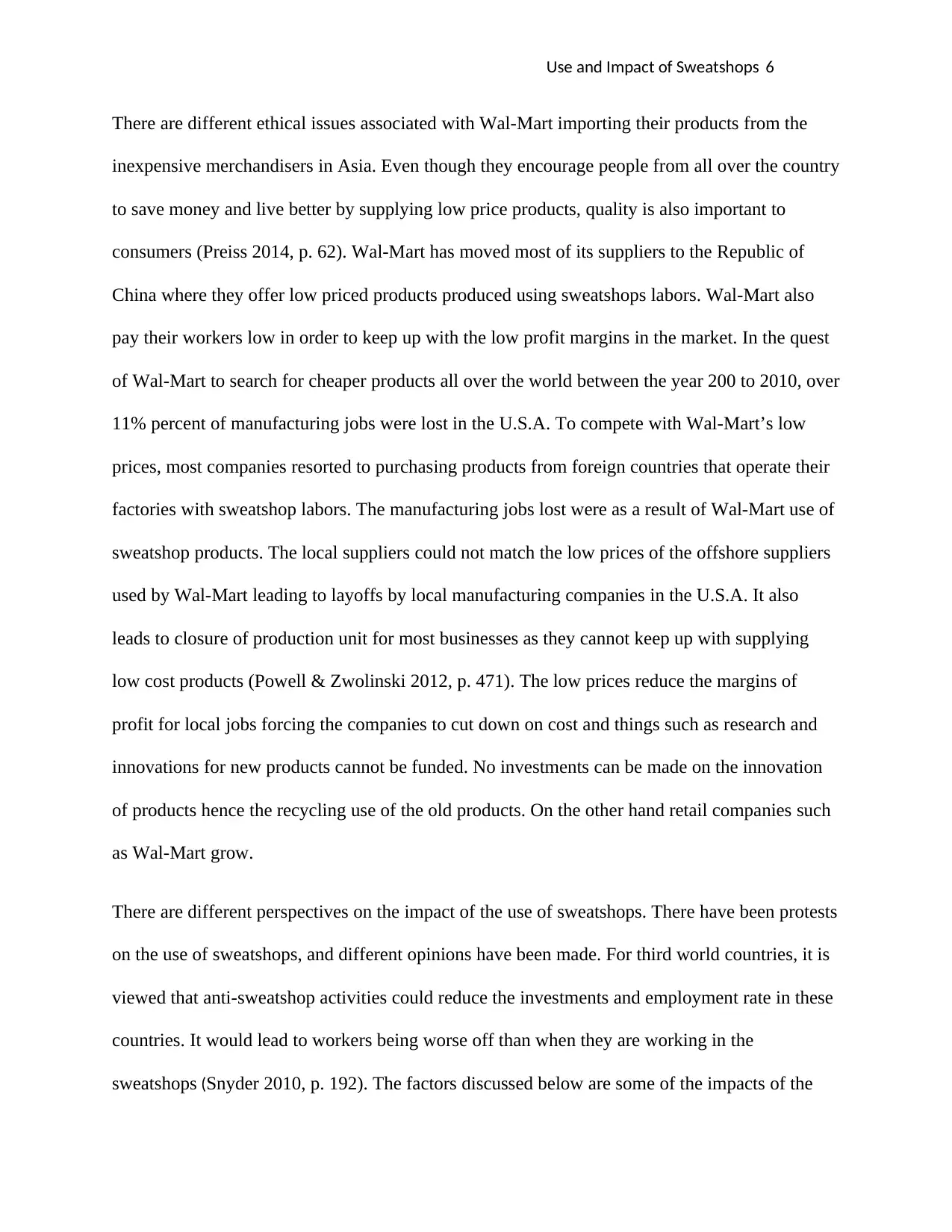
Use and Impact of Sweatshops 6
There are different ethical issues associated with Wal-Mart importing their products from the
inexpensive merchandisers in Asia. Even though they encourage people from all over the country
to save money and live better by supplying low price products, quality is also important to
consumers (Preiss 2014, p. 62). Wal-Mart has moved most of its suppliers to the Republic of
China where they offer low priced products produced using sweatshops labors. Wal-Mart also
pay their workers low in order to keep up with the low profit margins in the market. In the quest
of Wal-Mart to search for cheaper products all over the world between the year 200 to 2010, over
11% percent of manufacturing jobs were lost in the U.S.A. To compete with Wal-Mart’s low
prices, most companies resorted to purchasing products from foreign countries that operate their
factories with sweatshop labors. The manufacturing jobs lost were as a result of Wal-Mart use of
sweatshop products. The local suppliers could not match the low prices of the offshore suppliers
used by Wal-Mart leading to layoffs by local manufacturing companies in the U.S.A. It also
leads to closure of production unit for most businesses as they cannot keep up with supplying
low cost products (Powell & Zwolinski 2012, p. 471). The low prices reduce the margins of
profit for local jobs forcing the companies to cut down on cost and things such as research and
innovations for new products cannot be funded. No investments can be made on the innovation
of products hence the recycling use of the old products. On the other hand retail companies such
as Wal-Mart grow.
There are different perspectives on the impact of the use of sweatshops. There have been protests
on the use of sweatshops, and different opinions have been made. For third world countries, it is
viewed that anti-sweatshop activities could reduce the investments and employment rate in these
countries. It would lead to workers being worse off than when they are working in the
sweatshops (Snyder 2010, p. 192). The factors discussed below are some of the impacts of the
There are different ethical issues associated with Wal-Mart importing their products from the
inexpensive merchandisers in Asia. Even though they encourage people from all over the country
to save money and live better by supplying low price products, quality is also important to
consumers (Preiss 2014, p. 62). Wal-Mart has moved most of its suppliers to the Republic of
China where they offer low priced products produced using sweatshops labors. Wal-Mart also
pay their workers low in order to keep up with the low profit margins in the market. In the quest
of Wal-Mart to search for cheaper products all over the world between the year 200 to 2010, over
11% percent of manufacturing jobs were lost in the U.S.A. To compete with Wal-Mart’s low
prices, most companies resorted to purchasing products from foreign countries that operate their
factories with sweatshop labors. The manufacturing jobs lost were as a result of Wal-Mart use of
sweatshop products. The local suppliers could not match the low prices of the offshore suppliers
used by Wal-Mart leading to layoffs by local manufacturing companies in the U.S.A. It also
leads to closure of production unit for most businesses as they cannot keep up with supplying
low cost products (Powell & Zwolinski 2012, p. 471). The low prices reduce the margins of
profit for local jobs forcing the companies to cut down on cost and things such as research and
innovations for new products cannot be funded. No investments can be made on the innovation
of products hence the recycling use of the old products. On the other hand retail companies such
as Wal-Mart grow.
There are different perspectives on the impact of the use of sweatshops. There have been protests
on the use of sweatshops, and different opinions have been made. For third world countries, it is
viewed that anti-sweatshop activities could reduce the investments and employment rate in these
countries. It would lead to workers being worse off than when they are working in the
sweatshops (Snyder 2010, p. 192). The factors discussed below are some of the impacts of the
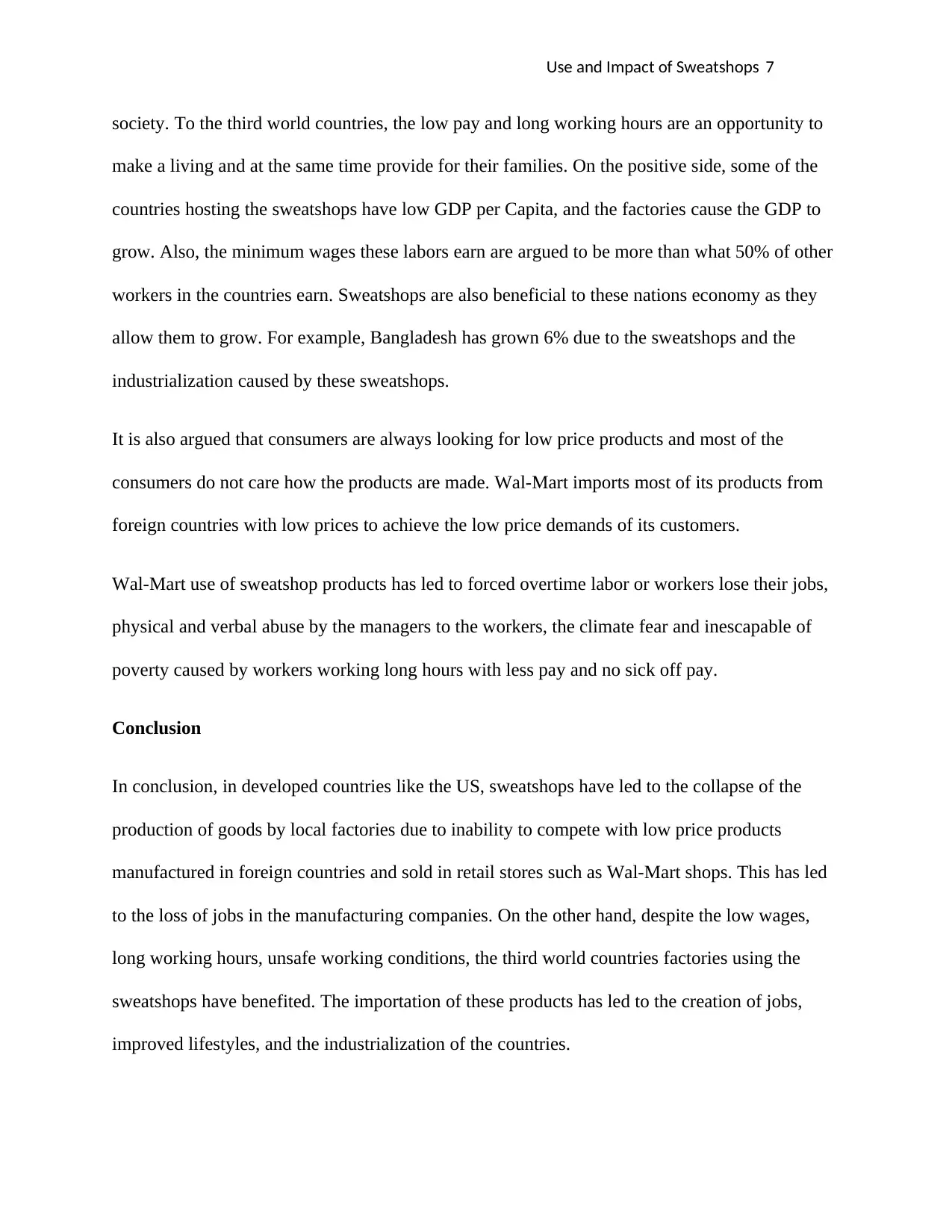
Use and Impact of Sweatshops 7
society. To the third world countries, the low pay and long working hours are an opportunity to
make a living and at the same time provide for their families. On the positive side, some of the
countries hosting the sweatshops have low GDP per Capita, and the factories cause the GDP to
grow. Also, the minimum wages these labors earn are argued to be more than what 50% of other
workers in the countries earn. Sweatshops are also beneficial to these nations economy as they
allow them to grow. For example, Bangladesh has grown 6% due to the sweatshops and the
industrialization caused by these sweatshops.
It is also argued that consumers are always looking for low price products and most of the
consumers do not care how the products are made. Wal-Mart imports most of its products from
foreign countries with low prices to achieve the low price demands of its customers.
Wal-Mart use of sweatshop products has led to forced overtime labor or workers lose their jobs,
physical and verbal abuse by the managers to the workers, the climate fear and inescapable of
poverty caused by workers working long hours with less pay and no sick off pay.
Conclusion
In conclusion, in developed countries like the US, sweatshops have led to the collapse of the
production of goods by local factories due to inability to compete with low price products
manufactured in foreign countries and sold in retail stores such as Wal-Mart shops. This has led
to the loss of jobs in the manufacturing companies. On the other hand, despite the low wages,
long working hours, unsafe working conditions, the third world countries factories using the
sweatshops have benefited. The importation of these products has led to the creation of jobs,
improved lifestyles, and the industrialization of the countries.
society. To the third world countries, the low pay and long working hours are an opportunity to
make a living and at the same time provide for their families. On the positive side, some of the
countries hosting the sweatshops have low GDP per Capita, and the factories cause the GDP to
grow. Also, the minimum wages these labors earn are argued to be more than what 50% of other
workers in the countries earn. Sweatshops are also beneficial to these nations economy as they
allow them to grow. For example, Bangladesh has grown 6% due to the sweatshops and the
industrialization caused by these sweatshops.
It is also argued that consumers are always looking for low price products and most of the
consumers do not care how the products are made. Wal-Mart imports most of its products from
foreign countries with low prices to achieve the low price demands of its customers.
Wal-Mart use of sweatshop products has led to forced overtime labor or workers lose their jobs,
physical and verbal abuse by the managers to the workers, the climate fear and inescapable of
poverty caused by workers working long hours with less pay and no sick off pay.
Conclusion
In conclusion, in developed countries like the US, sweatshops have led to the collapse of the
production of goods by local factories due to inability to compete with low price products
manufactured in foreign countries and sold in retail stores such as Wal-Mart shops. This has led
to the loss of jobs in the manufacturing companies. On the other hand, despite the low wages,
long working hours, unsafe working conditions, the third world countries factories using the
sweatshops have benefited. The importation of these products has led to the creation of jobs,
improved lifestyles, and the industrialization of the countries.
Paraphrase This Document
Need a fresh take? Get an instant paraphrase of this document with our AI Paraphraser

Use and Impact of Sweatshops 8
There is need to improve the working conditions and the safety tools to be used by the workers to
work in a safe environment.
There is need to improve the working conditions and the safety tools to be used by the workers to
work in a safe environment.
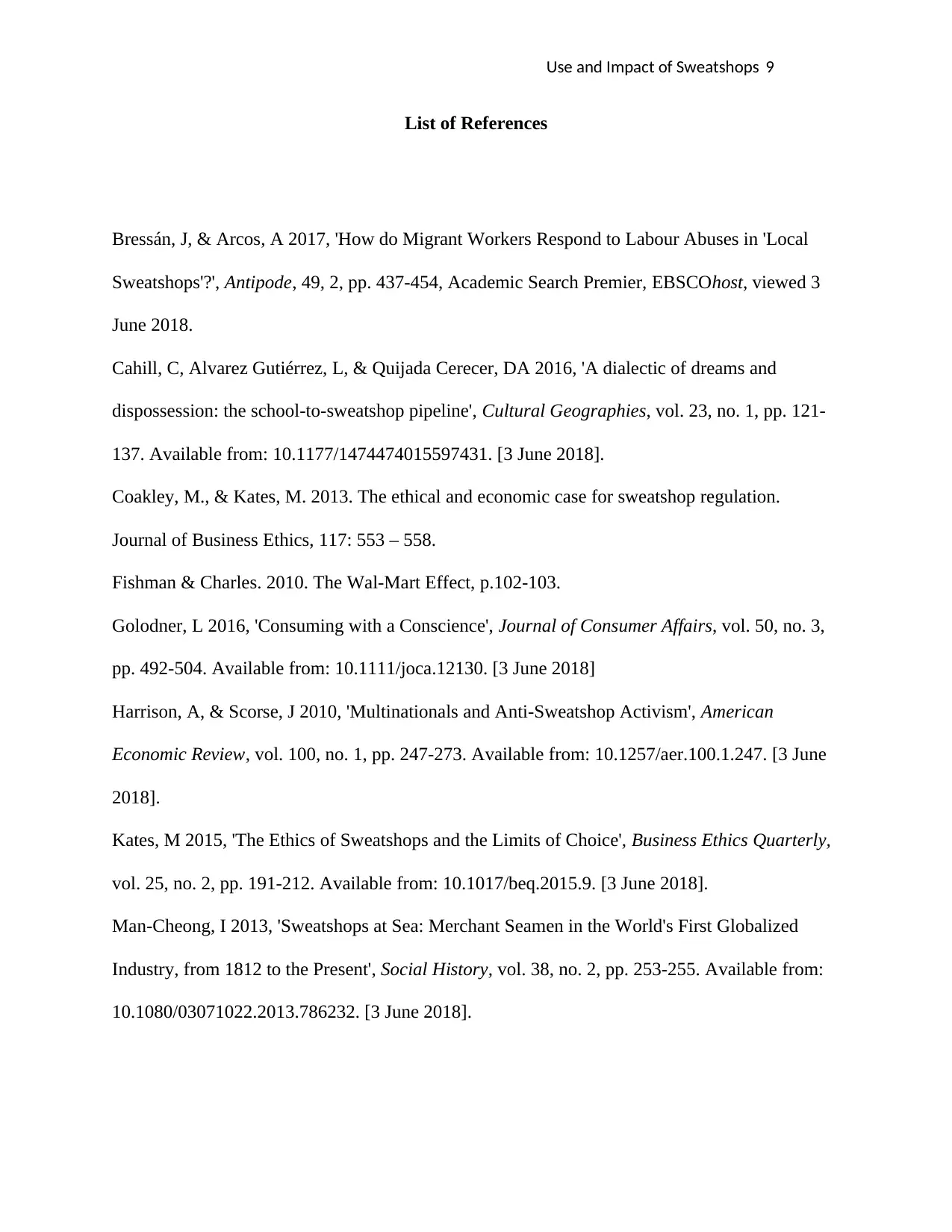
Use and Impact of Sweatshops 9
List of References
Bressán, J, & Arcos, A 2017, 'How do Migrant Workers Respond to Labour Abuses in 'Local
Sweatshops'?', Antipode, 49, 2, pp. 437-454, Academic Search Premier, EBSCOhost, viewed 3
June 2018.
Cahill, C, Alvarez Gutiérrez, L, & Quijada Cerecer, DA 2016, 'A dialectic of dreams and
dispossession: the school-to-sweatshop pipeline', Cultural Geographies, vol. 23, no. 1, pp. 121-
137. Available from: 10.1177/1474474015597431. [3 June 2018].
Coakley, M., & Kates, M. 2013. The ethical and economic case for sweatshop regulation.
Journal of Business Ethics, 117: 553 – 558.
Fishman & Charles. 2010. The Wal-Mart Effect, p.102-103.
Golodner, L 2016, 'Consuming with a Conscience', Journal of Consumer Affairs, vol. 50, no. 3,
pp. 492-504. Available from: 10.1111/joca.12130. [3 June 2018]
Harrison, A, & Scorse, J 2010, 'Multinationals and Anti-Sweatshop Activism', American
Economic Review, vol. 100, no. 1, pp. 247-273. Available from: 10.1257/aer.100.1.247. [3 June
2018].
Kates, M 2015, 'The Ethics of Sweatshops and the Limits of Choice', Business Ethics Quarterly,
vol. 25, no. 2, pp. 191-212. Available from: 10.1017/beq.2015.9. [3 June 2018].
Man-Cheong, I 2013, 'Sweatshops at Sea: Merchant Seamen in the World's First Globalized
Industry, from 1812 to the Present', Social History, vol. 38, no. 2, pp. 253-255. Available from:
10.1080/03071022.2013.786232. [3 June 2018].
List of References
Bressán, J, & Arcos, A 2017, 'How do Migrant Workers Respond to Labour Abuses in 'Local
Sweatshops'?', Antipode, 49, 2, pp. 437-454, Academic Search Premier, EBSCOhost, viewed 3
June 2018.
Cahill, C, Alvarez Gutiérrez, L, & Quijada Cerecer, DA 2016, 'A dialectic of dreams and
dispossession: the school-to-sweatshop pipeline', Cultural Geographies, vol. 23, no. 1, pp. 121-
137. Available from: 10.1177/1474474015597431. [3 June 2018].
Coakley, M., & Kates, M. 2013. The ethical and economic case for sweatshop regulation.
Journal of Business Ethics, 117: 553 – 558.
Fishman & Charles. 2010. The Wal-Mart Effect, p.102-103.
Golodner, L 2016, 'Consuming with a Conscience', Journal of Consumer Affairs, vol. 50, no. 3,
pp. 492-504. Available from: 10.1111/joca.12130. [3 June 2018]
Harrison, A, & Scorse, J 2010, 'Multinationals and Anti-Sweatshop Activism', American
Economic Review, vol. 100, no. 1, pp. 247-273. Available from: 10.1257/aer.100.1.247. [3 June
2018].
Kates, M 2015, 'The Ethics of Sweatshops and the Limits of Choice', Business Ethics Quarterly,
vol. 25, no. 2, pp. 191-212. Available from: 10.1017/beq.2015.9. [3 June 2018].
Man-Cheong, I 2013, 'Sweatshops at Sea: Merchant Seamen in the World's First Globalized
Industry, from 1812 to the Present', Social History, vol. 38, no. 2, pp. 253-255. Available from:
10.1080/03071022.2013.786232. [3 June 2018].
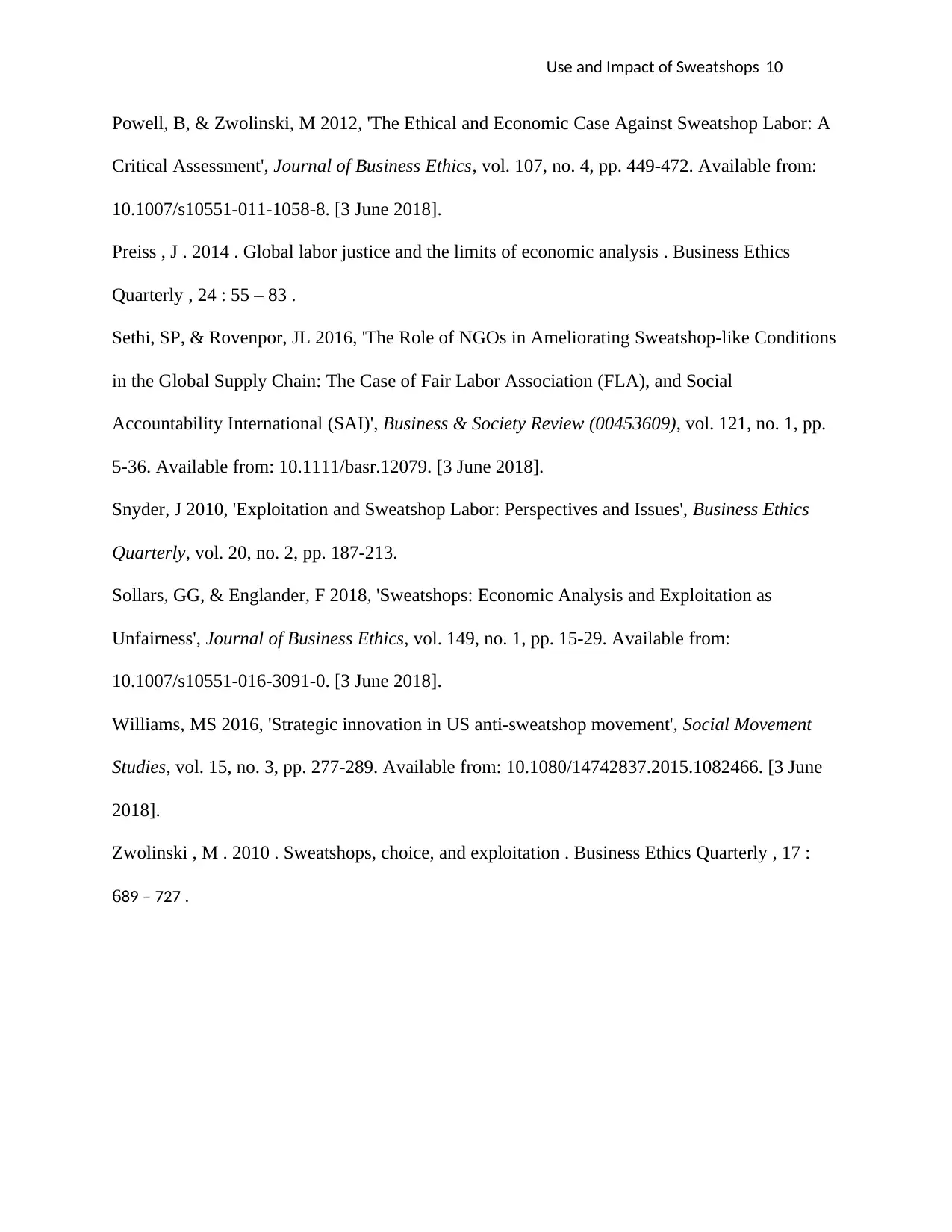
Use and Impact of Sweatshops 10
Powell, B, & Zwolinski, M 2012, 'The Ethical and Economic Case Against Sweatshop Labor: A
Critical Assessment', Journal of Business Ethics, vol. 107, no. 4, pp. 449-472. Available from:
10.1007/s10551-011-1058-8. [3 June 2018].
Preiss , J . 2014 . Global labor justice and the limits of economic analysis . Business Ethics
Quarterly , 24 : 55 – 83 .
Sethi, SP, & Rovenpor, JL 2016, 'The Role of NGOs in Ameliorating Sweatshop-like Conditions
in the Global Supply Chain: The Case of Fair Labor Association (FLA), and Social
Accountability International (SAI)', Business & Society Review (00453609), vol. 121, no. 1, pp.
5-36. Available from: 10.1111/basr.12079. [3 June 2018].
Snyder, J 2010, 'Exploitation and Sweatshop Labor: Perspectives and Issues', Business Ethics
Quarterly, vol. 20, no. 2, pp. 187-213.
Sollars, GG, & Englander, F 2018, 'Sweatshops: Economic Analysis and Exploitation as
Unfairness', Journal of Business Ethics, vol. 149, no. 1, pp. 15-29. Available from:
10.1007/s10551-016-3091-0. [3 June 2018].
Williams, MS 2016, 'Strategic innovation in US anti-sweatshop movement', Social Movement
Studies, vol. 15, no. 3, pp. 277-289. Available from: 10.1080/14742837.2015.1082466. [3 June
2018].
Zwolinski , M . 2010 . Sweatshops, choice, and exploitation . Business Ethics Quarterly , 17 :
689 – 727 .
Powell, B, & Zwolinski, M 2012, 'The Ethical and Economic Case Against Sweatshop Labor: A
Critical Assessment', Journal of Business Ethics, vol. 107, no. 4, pp. 449-472. Available from:
10.1007/s10551-011-1058-8. [3 June 2018].
Preiss , J . 2014 . Global labor justice and the limits of economic analysis . Business Ethics
Quarterly , 24 : 55 – 83 .
Sethi, SP, & Rovenpor, JL 2016, 'The Role of NGOs in Ameliorating Sweatshop-like Conditions
in the Global Supply Chain: The Case of Fair Labor Association (FLA), and Social
Accountability International (SAI)', Business & Society Review (00453609), vol. 121, no. 1, pp.
5-36. Available from: 10.1111/basr.12079. [3 June 2018].
Snyder, J 2010, 'Exploitation and Sweatshop Labor: Perspectives and Issues', Business Ethics
Quarterly, vol. 20, no. 2, pp. 187-213.
Sollars, GG, & Englander, F 2018, 'Sweatshops: Economic Analysis and Exploitation as
Unfairness', Journal of Business Ethics, vol. 149, no. 1, pp. 15-29. Available from:
10.1007/s10551-016-3091-0. [3 June 2018].
Williams, MS 2016, 'Strategic innovation in US anti-sweatshop movement', Social Movement
Studies, vol. 15, no. 3, pp. 277-289. Available from: 10.1080/14742837.2015.1082466. [3 June
2018].
Zwolinski , M . 2010 . Sweatshops, choice, and exploitation . Business Ethics Quarterly , 17 :
689 – 727 .
1 out of 10
Related Documents
Your All-in-One AI-Powered Toolkit for Academic Success.
+13062052269
info@desklib.com
Available 24*7 on WhatsApp / Email
![[object Object]](/_next/static/media/star-bottom.7253800d.svg)
Unlock your academic potential
© 2024 | Zucol Services PVT LTD | All rights reserved.





